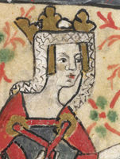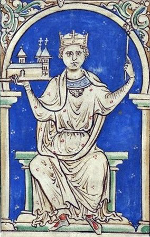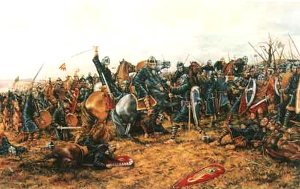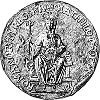The Anarchy: England's 12th-Century Civil War
England in the mid-12th Century was awash in a civil war between the daughter and nephew of a recently deceased king. The daughter was the Empress Matilda. The nephew was King Stephen. The recently deceased monarch was King Henry I, who had died without a male heir. Stephen claimed the throne, Matilda contested his claim, citing one of her own agreed on by a large number of English and Norman barons before Henry died, and the struggle between the two claimants lasted nearly two decades. This period in English history has come to be called The Anarchy. 
It began in 1120, when King Henry's only son, William Aetheling, died, one of nearly 300 people, many of them nobles, who were the victims of the sinking of the White Ship, which foundered on the short trip from France to England. Henry's only other child was Matilda, who was then married to the Holy Roman Emperor, Henry V of Germany. Henry and his wife had no other children. Henry gathered his principal supporters together in 1127 and had them swear allegiance to Matilda as queen when Henry died. By this time, she was known as the Empress Matilda. Stephen, meanwhile, was the uncle of England's King Henry I. He took up arms with his uncle, in the king's struggle against his own brother, Robert of Normandy. Henry knighted Stephen and gave him some land. A decade later, the king arranged a marriage for Stephen. He married Matilda of Boulogne. Henry genuinely liked Stephen and wanted him to succeed. Some of Henry's supporters thought that Stephen would make a good heir to the throne. Henry, who had arranged Matilda's first marriage when she was just 12, arranged another marriage for her in 1128, to a French count, Geoffrey of Anjou. She by this time was 25; he was only 14. They were married for several years and eventually had three children. King Henry I was visiting his daughter and her family when he died, in 1135. Stephen rushed to England. Matilda, who was pregnant, did not. 
Stephen claimed the throne (even though he had an older brother who could make a similar claim). His claim was that he was the favored nephew of the recent king and the grandson of William the Conqueror. Stephen also found ready support from several powerful barons who, even though they had pledged to respect the wishes of Henry I with regard to his succession, did not want to see a woman on the throne of England. Stephen also had the support of many powerful leaders of the English Church. His younger brother, Henry, was the Bishop of Winchester. And, the pope, Innocent II, had recognized Stephen as the legitimate King of England. Even so, Stephen was not universally loved. Stephen was crowned king on Dec. 26, 1125, in Westminster Abbey and immediately set about putting down objections to his monarchy. One of the first was from the Scottish king, David I (who was the uncle of the Empress Matilda). A Scottish force invaded northern England and claimed some disputed lands. The two sides fought, at the Battle of Standard, and the English were victorious. A generous settlement offered by Stephen at Durham convinced the Scottish force to go home. Among the settlement were some lands in northern England (notably Carlisle) owned by some of Stephen's supporters, who were none too happy with the arrangement. In 1136, southern Wales was the scene of a rebellion against Stephen's reign. William the Conqueror had built a number of castles in the Welsh Marches, on the border between England and Wales. The Welsh resented this and, when Henry I died, saw their opportunity to take advantage of the uncertainty in England. Stephen sent a force to put down the rebellion; it was not successful. In fact, Stephen lost 500 men in the Battle of Llwchwr. This was enough to convince Stephen to turn his focus elsewhere, notably Normandy, which by this time had been taken over by Geoffrey of Anjou, husband of the Empress Matilda. Stephen had no success in this endeavor and had to sue for peace. King David I of Scotland was back on the offensive in 1138, leading another invasion of northern England. At the same time, one of Stephen's prime supporters, Robert of Gloucester, threw in his lot with the Empress Matilda, who happened to be his half-sister. Robert was a powerful and influential man who had much money and resources and proved a formidable enemy for the often indecisive Stephen. Another arrangement between David and Stephen again sent the Scottish force home, albeit with another transfer of northern English land from England to Scotland. In 1139, Robert of Gloucester and the Empress Matilda were at the head of an invasion force that moved from Normandy to England. The Empress Matilda appealed to the pope to nullify Stephen's rule; he refused. Stephen's actions in his dealings with Scotland and Wales convinced several other of his supporters, including his brother Henry, to remove their allegiance to the king. Henry, in particular, was incensed at Stephen's arresting of a number of prominent bishops, on suspicion of treason. Robert of Gloucester took a number of men to the west. Matilda occupied Arundel Castle, which was nearly impregnable but was in relatively little time surrounded by Stephen's forces. Stephen allowed Matilda to go free, and she went to meet up with Robert in Bristol. 
Another powerful baron who changed sides was Robert of Gloucester's son-in-law, Ranulf of Chester, who captured the powerful castle at Lincoln. (Ranulf was on the men whose land Stephen had given away to Scotland.) Stephen led a force to retake the castle and was himself captured, in 1141. The Empress Matilda took great delight in keeping Stephen captive, while marching on London and proclaiming herself By this time, Stephen was in control again of most of the country. The position of the Empress Matilda was not strong. She retreated to Oxford, where Stephen's force settled in for a siege. In 1142, the Empress Matilda made a daring escape in the dead of night, escaping Oxford by wearing white and walking across the snowy ground and frozen River Thames to safety at Wallingford. The unrest continued, at a lower level, for a few more years. Robert of Gloucester died in 1147, and the Empress Matilda returned to Normandy. Stephen consolidated his hold on the country, but some resistance remained. One of the prime leaders of this limited resistance was Henry, oldest son of the Empress Matilda. He led a few sorties into England but gained little traction. At one point, he tried to coordinate a joint attack with Scotland's King David I, but Stephen got the upper hand there as well. Stephen's wife, Queen Matilda, died in 1152. Eustace, Stephen's son and heir to the throne, died in 1153. In that same year, Stephen and Henry agreed to the Treaty of Winchester (also know as the Treaty of Wallingford). Among the terms of that treaty were that Henry recognized Stephen's right to the throne for as long as he lived and that Stephen recognized Henry as his heir and successor. King Stephen died in 1154, and the oldest son of the Empress Matilda became King Henry II of England. |
|
Social Studies for Kids
copyright 2002–2026
David White



 queen. She seized the royal coffers and even had minted coins with her name on them. She referred to herself as queen. (She is sometimes referred to as Queen Maud.) She did not have the support of the people, however, and so was never crowned (thus another of her names, the "Lady of the English"). Stephen's brother Henry switched sides again, returning to support for his brother, and rallied men and money to the cause. Stephen's wife, meanwhile, Queen Matilda, had raised an army in response to Stephen's capture, and that army routed Robert's army and captured Robert. The Empress Matilda then agreed to a prisoner swap, Robert for Stephen.
queen. She seized the royal coffers and even had minted coins with her name on them. She referred to herself as queen. (She is sometimes referred to as Queen Maud.) She did not have the support of the people, however, and so was never crowned (thus another of her names, the "Lady of the English"). Stephen's brother Henry switched sides again, returning to support for his brother, and rallied men and money to the cause. Stephen's wife, meanwhile, Queen Matilda, had raised an army in response to Stephen's capture, and that army routed Robert's army and captured Robert. The Empress Matilda then agreed to a prisoner swap, Robert for Stephen.
